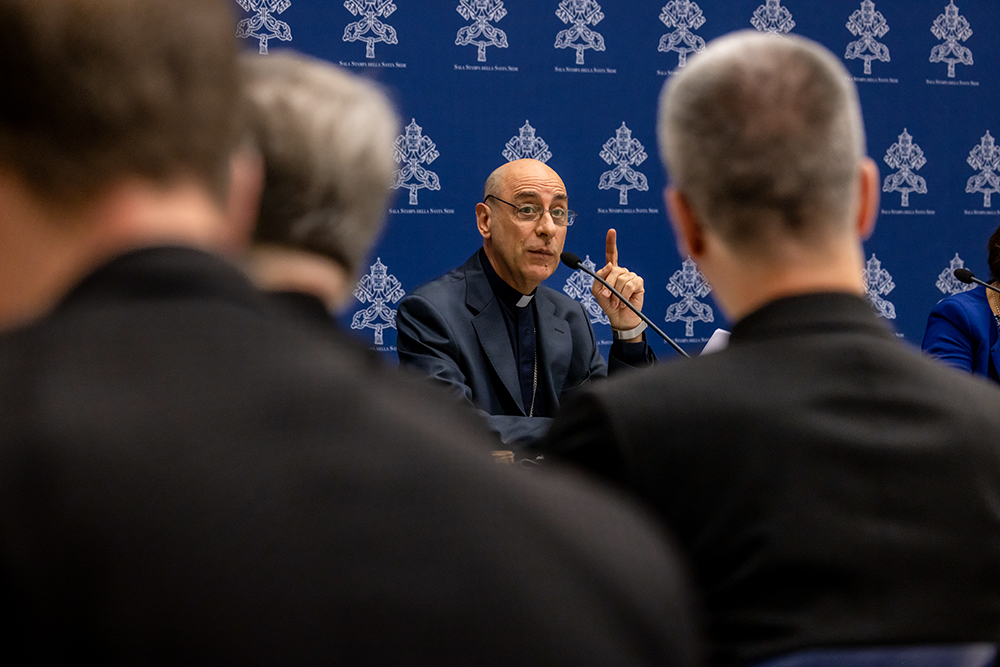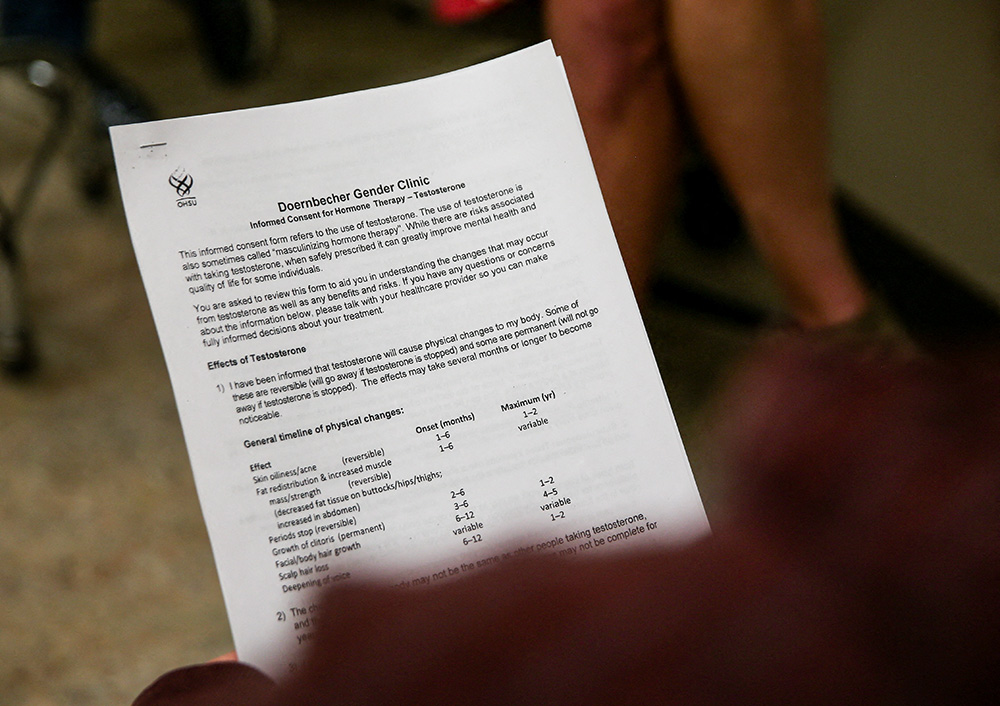
Cardinal Víctor Manuel Fernández, prefect of the Dicastery for the Doctrine of the Faith, speaks at a news conference to present the dicastery's declaration Dignitas Infinita at the Vatican press office April 8. Priests from the dicastery's doctrinal section joined reporters for the presentation. (CNS/Pablo Esparza)
I first encountered gender ideology when I was 6 years old. My catechism class was gathered in the sanctuary of St. Petronille Church. We were learning about the Mass from a young priest. He talked excitedly about the role of acolytes, which, given my already-powerful draw to God and the liturgy, lit up my being. He asked who wanted to sign up.
My hand shot into the air. I will never forget his expression as he looked at me wide-eyed, the color draining from his face.
"Girls can't be altar boys," he stammered.
I looked back and thought: "Well, that's the stupidest thing I've ever heard." There was nothing progressive about my family of origin, so I've always attributed that assessment to divine inspiration.
I was too young at the time to know that the structure of stupidity that I ran into in that sanctuary was everywhere. It was 1969. Had I been older, I would not have been able to run in the Boston Marathon, apply to the University of Notre Dame, get a credit card without a male co-signer, and much more. The culture, as well as the church, were powerfully shaped by gender ideology.
Thankfully, many of these ideologically driven exclusions fell before I had to encounter them. And 52 years later, in 2021, the church finally decided that actually, after all, girls can be acolytes. But the tentacles of gender ideology cling perniciously, as we see in Dignitas Infinita.
Dignitas Infinita reads like two documents, shaped by very different perspectives, that were cut-and-pasted together.
Dignitas Infinita opens with a careful description of how the document was developed. Drafted and approved by the Dicastery for the Doctrine of the Faith prior to Cardinal Victor Manuel Fernández's appointment as the head of the dicastery in July 2023, it appears to have focused solely on the usual narrow list of bioethics/culture war issues. Pope Francis, however, asked that the document be amended to incorporate insights from Fratelli Tutti.
As Fernández notes, they had to go back and redraft the document, cutting material at the beginning and expanding the list of issues.
This explains why Dignitas Infinita reads like two documents, shaped by very different perspectives, that were cut-and-pasted together. One thread emphasizes the "infinite" dignity of each person (1, 2). This dignity "is bestowed upon us by God" (11) out of God's love for each human being (11, 18). It is inviolable (11), intrinsic (15, 22, 23), and inalienable (22). The image of God indelibly imprinted on each human person (18) "from the beginning of [their] existence" (22), this dignity "remains 'in all circumstances'" (24).
In other words, this thread repeatedly emphasizes that all human beings stand as equals in their very being — or, in the words of the document, ontologically.
Why make this claim? Because both historically and today, real or fictional differences between people have been "ontologized" — projected into their very being and worth — and then used to justify violence, discrimination and other forms of dehumanization. Differences between rich/poor, compatriot/enemy, citizen/migrant, law-abiding/criminal, abled/disabled, healthy/sick, Black/white have provided the basis for death-dealing ideologies of neoliberal economics, militarism, nationalism, slavery, health and more. (Tragically, in Dignitas Infinita, the sole mention of racism is obliquely buried in a list [32]).
The first half of Dignitas Infinita upends these claims. It rejects a long list of supposed differences as false constructs. Insisting that all people are equal in ontological dignity, it deems practices premised on supposed differences between persons — e.g., poverty, war, death penalty, torture, human trafficking, sexual abuse, violence against women, abortion, euthanasia and the mistreatment of migrants and people with disabilities — to be gravely wrong.
Until Paragraph 56.
Suddenly, difference becomes completely determinative. Gender theory, the document states, is "extremely dangerous" because it "cancels differences" (56). It denies "the greatest possible difference that exists between living beings" — the "foundational difference" — "the greatest imaginable difference" (58) — "the ineliminable sexual difference" (59). Difference. Difference. And in case you missed it ... difference.
Advertisement
And what is that difference? "Sexual difference" (58, 59). In three paragraphs, the word "difference" is hammered home over and over and over. In fact, except for one other reference (28, the difference between humans and other living creatures), this is the only place where difference is mentioned. And it is asserted repeatedly in rapid-fire succession.
In other words, where the ontological equality of persons underlies Paragraphs 1-55, when it turns to "gender theory" and medical interventions for transgender people, Dignitas Infinita quadruples down on the supposed ontological differences between men and women.
This dissonance severely compromises the text. Paragraphs 56-60 read like remnants of a second document inelegantly grafted into the first. Here, the Dicastery for the Doctrine of the Faith simply reasserts the church's long-standing gender ideology, now known as "gender complementarity."
A "gender theory" that emerged in the second half of the 20th century, gender complementarity projects superficial biological differences back into the very essence of human nature to assert that between men and women there is the greatest possible foundational ineliminable difference imaginable.
This gender theory — or, we might call it, "gender idolatry" — leads to myriad problems both within and beyond the document.
Dignitas Infinita marks the first time the Holy See has issued an authoritative statement that takes up the novel, complex and politically fraught topic of medical interventions for transgender persons. What was needed — and widely hoped for — was a careful, informed and helpful analysis. Instead, the dicastery gave us one jumbled paragraph that demonstrates that it neither knows what it is talking about nor has even begun to conduct a decent theological analysis.

A person holds a consent form for testosterone therapy during an appointment at Oregon Health & Science University's Doernbecher Gender Clinic in Portland, Oregon, May 10, 2022. (OSV News/Reuters/Lindsey Wasson)
As Franciscan Fr. Daniel Horan has noted, the document irresponsibly caricatures and misrepresents both contemporary challenges to traditional gender theory and the realities of transgender persons and their medical care.
Vincentian Fr. Dennis Holtschneider has helpfully outlined a number of problems with the document's theological method.
Like last year's U.S. bishops' document on gender-affirming medical interventions, the dicastery appears to have simply ignored Francis' directives — captured most fully in his November 2023 motu proprio, Ad Theologiam Promovendam — that theology (both systematic and moral) necessarily requires careful engagement with the sciences, dialogue and a contextual approach.
Second, the blinders of gender complementarity lead the dicastery to make dramatic overstatements. As noted earlier, gender theory is named as "extremely dangerous," a phrase only otherwise used in this document with regard to abortion (56, 47). Desiring personal determination is (apparently for women) the equivalent of idolatry (57). Challenging traditional gender ideology will apparently "eliminat[e] the anthropological basis of the family" (59). For, as the document makes clear, there really is only one purpose for human bodies — mating and "generating other persons" (60, 58).
Third, this ideological commitment to gender complementarity renders the document incoherent in more ways than one. It is precisely this belief that men and women are so utterly, inherently different that is used to justify the horrific violence against women that Dignitas Infinita denounces in Paragraphs 44-46.
It is also enmeshed with a theologically fringe notion of "moral dignity" that can be "lost" (see 7). We see in the document an argument between this strange claim and the Catholic tradition's commitment to the inviolable and inalienable infinite dignity of each person (see the loopy discussion of "freedom" in 29-32).
Finally, in turning to its consideration of "Some Grave Violations of Human Dignity," Dignitas Infinita opens with a passage from Gaudium et Spes that lists myriad offenses against human dignity (34). When Pope John Paul II reappropriated that very paragraph in Veritatis Splendor, he relabeled the offenses as "intrinsically evil acts" (80).
There is little in this document that reflects Pope Francis' approach. We hear nothing of joy, accompaniment, dialogue, social friendship or synodality.
Here, the dicastery adds "gender theory" to this list. In doing so, it has not only ignored or dismissed the hard, careful and faithful work done by hundreds of Catholic theologians over the past half century who have tirelessly sought to demonstrate why the church's gender ideology is theologically at odds with the central doctrinal convictions of the Catholic faith. It appears that the dicastery also has shockingly now categorized the work of these theologians as intrinsically evil.
These are just a few of the problems internal to the document introduced by this non sequitur grasping of the church's gender ideology. Of course, the external ramifications of this ideology are much greater.
It is used to justify the church's continued exclusion of women from almost all ecclesial roles. It is at the root of the clergy sex abuse crisis — which embarrassingly receives no treatment in this document ("sexual abuse" is treated in a scant five sentences with no mention of clergy sexual abuse or episcopal complicity therein — see 43).
It is the foundation of most of the church's positions related to sexuality and bioethics, fueling most of the culture-war issues. And it continues to shape the ethos at most Catholic institutions. My encounter in the sanctuary in 1969 was only the first — and far from the worst — instance of the church's gender ideology that I have experienced or seen.
Overall, while Dignitas Infinita rightly emphasizes the infinite dignity of each human person, including the poor, migrants, those who are trafficked and who are LGBQI, and more, there is little in this document that reflects Francis' approach. We hear nothing of joy, accompaniment, dialogue, social friendship or synodality. There is nothing here of the careful, nuanced, and transformative theological work of Lumen Fidei, Evangelii Gaudium, Laudato Si' or Fratelli Tutti.
Rather, Dignitas Infinita fails to treat women and transgender persons with the basic respect and consideration their dignity requires (45). But in recognizing that "inequalities in these areas are also various forms of violence" (45), it provides a starting point for crucial conversations going forward that might at last dismantle the church's own gender ideology. I pray that that won't take another 52 years.








